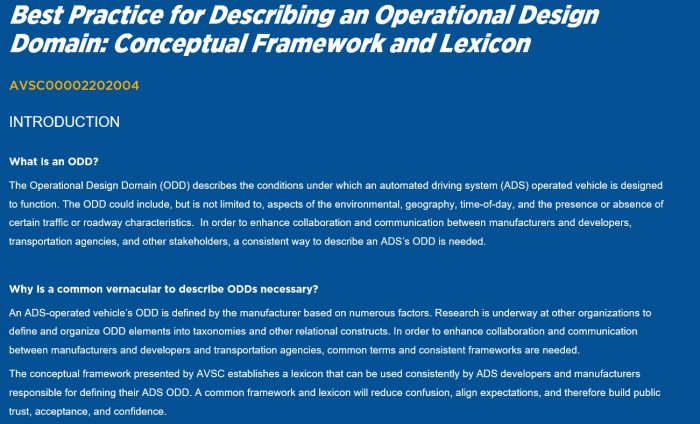Latest best practice provides recommendations for a common framework and vocabulary to help guide the on-road testing of SAE Level 4 autonomous vehicles
WARRENDALE, Pa.– The Automated Vehicle Safety Consortium™ (AVSC) today announced the availability of its second published best practice titled, Describing an Operational Design Domain (ODD): Conceptual Framework and Lexicon. The best practice provides a much-needed conceptual framework and common language that all manufacturers and developers can use in defining and communicating the ODD for their automated driving systems (ADS)-operated vehicles with users.
This framework guidance provides a starting point for transportation agencies and industry to better communicate with each other and the public about deployments, tests and operations of AVs that meet SAE Level 4 as defined by the SAE J3016™ “Levels of Driving Automation” Standard.
“In order for highly-automated vehicles to operate safely on public roads, developers and manufacturers need to work from a common framework and use a common lexicon so there is consistency in their descriptions of capabilities,” said Dr. Edward Straub, executive director of the AVSC. “The guidelines in this best practice will help reduce confusion, align expectations across stakeholders, streamline communication and ultimately take another important step forward in building public trust, acceptance, and confidence in SAE Level 4 vehicles on our roadways.”
The AVSC’s conceptual framework and lexicon balance the need for granularity with practical usability. This guidance and specificity are important as operators and transportation agencies develop AV technology and the supporting infrastructure.
The lexicon includes terms related to weather-related conditions, road surface conditions, roadway infrastructure, operational constraints such as rush hour and zone restrictions, road users, non-static roadside objects, and connectivity. To build the lexicon, the AVSC leveraged relevant industry standard terms and definitions and consolidated from many sources such as The American Association of State Highway and Transportation Officials (AASHTO), the National Weather Service (NWS), and the National Oceanic and Atmospheric Administration (NOAA).
“This is an evolving topic and we expect this document to evolve as we leverage new information and experiences,” added Dr. Straub. “We appreciate the contributions of all our members who contributed to this much-needed resource.”
For a more technical overview, SAE International’s Automotive Engineering magazine published an overview of the new best practice in its May 2020 edition.
To download the full best practice, visit avsc.sae-itc.org and click on Our Work.
The Automated Vehicle Safety Consortium™ (AVSC) is an industry program of SAE Industry Technologies Consortia (SAE ITC®) building on principles that will inform and help lead to industrywide standards for advancing automated driving systems. The members of this consortium have long been focused on the development of safe, reliable and high-quality vehicles, and are committed to applying these same principles to SAE Level 4 and Level 5 automated vehicles so communities, government entities and the public can be confident that these vehicles will be deployed safely.
SAE Industry Technologies Consortia (SAE ITC®) is an affiliate of SAE International. The SAE ITC team specializes in establishing and managing consortia by providing proven processes, tools and resources. ITC enables public, private, academic and government organizations to connect and collaborate in neutral, pre-competitive forums thus empowering the setting and implementation of strategic business improvements in highly engineered industries globally. (http://www.sae-itc.com)



